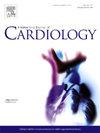Gender disparities in cangrelor usage for the treatment of patients with acute coronary syndrome undergoing percutaneous coronary intervention
IF 3.2
2区 医学
Q2 CARDIAC & CARDIOVASCULAR SYSTEMS
引用次数: 0
Abstract
Background
Cangrelor is a rapid, potent intravenous P2Y12 inhibitor that reduces thrombotic and ischemic events in patients with myocardial infarction (MI) undergoing percutaneous coronary intervention (PCI). This study aimed to investigate gender disparities in Cangrelor usage, efficacy, and safety across gender in patients presenting with acute coronary syndrome (ACS) undergoing PCI.
Methods
This is an observational retrospective analysis included patients presented with ACS who underwent PCI and received Cangrelor at MedStar Washington Hospital Center (2018–2023). Access to Cangrelor across gender was recorded. The primary safety outcome was in-hospital thrombolysis in myocardial infarction (TIMI) major bleeding, while the primary efficacy outcome was in-hospital major adverse cardiac events (MACE): defined as the composite of in-hospital cardiac death, MI, and stroke. A control group was investigated gender disparities in patients with ACS who did not receive Cangrelor.
Results
A total of 2859 patients with ACS underwent PCI (991 women and 1868 men). Among these patients, women were less likely to receive Cangrelor during PCI compared to men (40.2 % vs. 48 %; P < 0.001). The Cangrelor cohort consisted of 1295 patients (398 women, 897 men), and among those, women had significantly higher rates of in-hospital TIMI major bleeding (3.5 % vs. 0.6 %; P < 0.001) and higher in-hospital MACE (5.0 % vs. 1.3 %; P < 0.001) compared to men. Multivariate modeling after adjusting for differences in baseline characteristics showed that women were associated with increased TIMI major bleeding (OR 4.02, 95 %CI 1.09–14.79; P 0.037), but not in-hospital MACE (OR 2.11, 95 %CI 0.88–5.07; P 0.096). In the non-Cangrelor cohort, there were no significant difference between women and men in TIMI major bleeding (0.8 % vs. 0.9 %, P = 0.865) and MACE (1.5 % vs. 1.6, P = 0.842).
Conclusion
In patients presenting with ACS, women who received cangrelor had higher rates of TIMI major bleeding, without an impact on MACE. This may partially explain why women with ACS undergoing PCI receive less cangrelor compared to men. Therefore, increased bleeding events in women receiving cangrelor warrant further investigation.

经皮冠状动脉介入治疗急性冠状动脉综合征患者使用康瑞洛的性别差异
背景:cangrelor是一种快速、有效的静脉注射P2Y12抑制剂,可减少心肌梗死(MI)患者接受经皮冠状动脉介入治疗(PCI)时的血栓形成和缺血事件。本研究旨在探讨急性冠脉综合征(ACS)行PCI治疗的患者在angrelor的使用、疗效和安全性方面的性别差异。方法观察性回顾性分析纳入MedStar Washington医院中心(2018-2023)行PCI治疗并接受康格瑞洛治疗的ACS患者。记录了跨性别使用angrelor的情况。主要的安全性终点是院内溶栓导致的心肌梗死(TIMI)大出血,而主要的疗效终点是院内严重心脏不良事件(MACE):定义为院内心源性死亡、心肌梗死(MI)和脑卒中的复合。对照组研究未接受康格乐治疗的ACS患者的性别差异。结果共2859例ACS患者行PCI治疗,其中女性991例,男性1868例。在这些患者中,与男性相比,女性在PCI期间接受康格洛的可能性更低(40.2%比48%;P & lt;0.001)。canrelor队列包括1295名患者(398名女性,897名男性),其中,女性的院内TIMI大出血率明显更高(3.5%对0.6%;P & lt;0.001)和更高的住院MACE (5.0% vs. 1.3%;P & lt;0.001)。调整基线特征差异后的多变量模型显示,女性与TIMI大出血增加相关(OR 4.02, 95% CI 1.09-14.79;P 0.037),但与院内MACE无关(OR 2.11, 95% CI 0.88-5.07;P 0.096)。在非angrelor队列中,女性和男性在TIMI大出血(0.8%比0.9%,P = 0.865)和MACE(1.5%比1.6,P = 0.842)方面没有显著差异。结论:在ACS患者中,接受canrelor治疗的女性TIMI大出血发生率更高,但对MACE没有影响。这可能部分解释了为什么接受PCI治疗的ACS女性比男性接受更少的化疗。因此,服用康格洛的女性出血事件增加值得进一步调查。
本文章由计算机程序翻译,如有差异,请以英文原文为准。
求助全文
约1分钟内获得全文
求助全文
来源期刊

International journal of cardiology
医学-心血管系统
CiteScore
6.80
自引率
5.70%
发文量
758
审稿时长
44 days
期刊介绍:
The International Journal of Cardiology is devoted to cardiology in the broadest sense. Both basic research and clinical papers can be submitted. The journal serves the interest of both practicing clinicians and researchers.
In addition to original papers, we are launching a range of new manuscript types, including Consensus and Position Papers, Systematic Reviews, Meta-analyses, and Short communications. Case reports are no longer acceptable. Controversial techniques, issues on health policy and social medicine are discussed and serve as useful tools for encouraging debate.
 求助内容:
求助内容: 应助结果提醒方式:
应助结果提醒方式:


